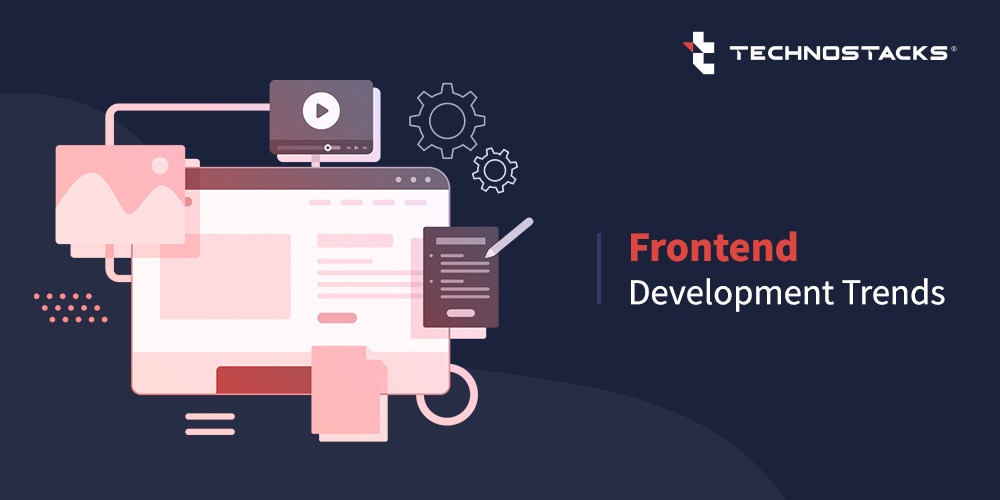Top Front End Development Trends for Web Developers
Front-end development refers to creating the user interface of a web portal using coding and other applications such as HTML, CSS, and JavaScript. Here we are going to discuss predictions for front-end development trends in 2021-2022.
The front-end in the word front-end development refers to that side of the website which a client or web user encounters. Similarly, a front-end developer does front-end development and programs the straightforward user interface of a website.
On the other hand, back-end development is the development of that section of the web portal used by the owners or technical creators. Back-end development includes storing data, running the website, and enabling layouts.
The growing importance and relevance of online shopping front-end development trends are gaining momentum. Trends are being set and changed quickly and mainly on the whims of customers.
Keeping up with changing trends in front-end development, let’s explore what is actually beneficial for frontend developers.
How does Front-end Development Work?
Frontend web development involves making that part of a website with which customers interact and engage. For example, if you open an online shopping website, the photos, sections to shop with, and sales deals are part of the front-end.
In contrast, the back-end refers to the website that the owners, managers, or the admin of the website encounter, like orders, receipts, and stored data.
Front-end developers must ensure that the interface is attractive, user-friendly, and navigable. It is the prime duty of developers to make the interface not only beautiful but also practical and convenient.
A clean, structured layout, clear business intent, and impressive graphics all vastly help an enterprise and are all part of front-end development as a technology solution.
Front-end Development Trends
Front end trends are fads and change very quickly. So, keeping up with these vital trends can be hectic for developers. However, front-end development trends play a significant role in refining a web portal.
A prominent organization adopts a front-end trend in the software industry, and micro-organizations soon follow it; the movement doesn’t just pop up. Instead, there is a recognizable pattern behind it.
However, any trend should be adopted such that it doesn’t hinder the user-friendliness or easy navigation of the website; a unique webpage that one can’t figure out is of no use.
Trends Frontend Developers Should Be Aware
Here is an inclusive list of some of the latest and eye-catching trends that you should catch up with if you haven’t already with Front-end Development.
- The Superiority of Java
When it comes to popular frameworks that can be used to make a front-end, Java always comes on top; and it is pretty unbeatable. Since its inception, Java has been promising and has constantly evolved to incorporate transformations in the software industry.Despite altering trends, multiple frameworks, and a range of libraries, Java has been rock-solid and is behind numerous successful web apps. And it continues to be part of front-end development trends even in 2021-2022 and upcoming years. - Enable Typescript
Typescript is a software language developed by Microsoft and is a syntactical subset within Java but provides an additional and optional static typing tool.You can use typescript on an existing application or code; typescript ensures seamless integration with all complex languages on the web, being part of our 2021 trend list.Also read:- Best Frontend Frameworks - Facilitate Headless Architecture
Netflix first incorporated the headless architecture, and soon the headless software market grew at impressive rates. Headless CMS adeptly handles and enables multiple site management.Multiple site management refers to angling multiple sites, pages, and micro-sites through a single platform. This can quickly launch various sites, improve efficiency, allow global mobilization, and much more.A headless CMS has added benefits like increased scalability, a resume of content for separate web portals, otherwise not possible, a command center that provides for greater freedom in editing. And it also eliminates the need to do things twice or more times on separate web pages. - Use Micro Frontend Architecture
Front-end trends also feature development strategies like micro front-end architecture. This architecture eases the process of website management, and one production can handle multiple apps. - Opting for Static Web Portals
Static websites are not a new thing, and just when people started thinking that they were gone, static web portals made a comeback. These websites are cheaper and require low maintenance. They are faster and more secure.Static websites smartly use front-end development functionalities and don’t need advanced back-end development, and need only a few HTML pages to be published on the web server. - Increasing Use of Single-page Applications
Single-page applications have become popular because they are quicker and cost-effective to develop. In addition, single-page applications prevent websites from getting overloaded with complex content and graphics.A unique benefit of single-page applications is that they are incredibly mobile-friendly and can conveniently be turned into mobile applications and web portals. - Switch to Low-code App Development
Within the realm of app development, low-codes are gaining quick momentum. Low code app development helps businesses build apps with very little hand-coding, and thus lesser time is required without compromising on user satisfaction.By reducing the time spent on manual coding, they can significantly reduce efforts, costs, improve and augment the development of an application.Also read:- Front-End Development Tools - Adopt Component-based Development
Component-based development is centered around building applications on the coupled models with a central focus on ensuring the reusability of the components and involved elements.This allows for faster creation, better working, enhanced merging, and higher levels of customer satisfaction. In addition, this type of development in the front end is the reason behind easier code maintainability and better sustenance. - Allow Progressive Web Applications
Most of the companies are moving towards making advanced web applications functional within their existing and current applications. This negates the requirements to have a separate native application, and the company can enjoy extra benefits by enabling progressive web applications. - Decode JAMstack
JAMstack is an acronym for Java, APIs, and Markup; the trio is used as a stack which has become a strong front-end development trend of 2021, and it is expected to continue in 2022. It better involves automated functioning, deploying, and cache invalidation in seconds.These are the most emerging Front End Development Trends for upcoming years and should be incorporated by every aspiring frontend developer.While some of these are new, others are transformations of older trends, and even others are so primal in web development that they cannot be ignored.The latest trends in front-end development like JAMstack or the continuous triumph of JavaScript are here to stay and are of crucial significance in front-end development.
Importance of Front End Development Trends
The front end of a web portal is the integral part that customers view when they first open it. It helps make the first impression, conveys the web portal’s goals, and attracts a customer base.
Front End Development is Essential for Business Success; here are some reasons why –
- Creates an Enhanced ImpressionFront-end development gives a first impression – whether good, bad or average. The type of styling, color schemes, pictures used, and graphics all contribute to a customer’s first impression.Most of the web portals are judged for their initial appearances by their prospects, probable partners, and esteemed clients.
- Improves BrandingThe relevance of front-end development in branding cannot be stressed enough. For example, a website’s graphics vastly help build a brand image. It convinces both the involved internal and external stakeholders.When people see unique designs or attractive graphics, they are immediately attracted to the web portal. With enhancements in the branding, the chances of converting visitors to customers increase significantly.
- Build Trust & ReliabilityThe web portals with poor design, runtime errors, development problems, extended periods for opening, and HTML issues are likely to create negative opinions in viewers’ minds.With website challenges, many people consider businesses as frauds. Some would dislike such business setups and probably not return after their first visit.
- Enables Better NavigationFront-end development offers developers the power to ensure user navigation to be smooth and seamless. A website that doesn’t allow users to shop, navigate or move around is bound to fail.With proper front-end development, visitors would enjoy the website’s navigation and be impressed with the content flow.
- Helps with Visitor RetentionIt would be commonplace to point out how a well-planned site layout, user-friendliness, good graphics, and clean setups improve visitor retention.
- Assists with Aligning Business IntentWhat viewers see on first opening a website conveys a lot about the professional intent of the company owners. With effective use of front-end development, one can articulately express their business intent and attract customers.
Key Takeaways
Front-end development refers to the process of making a friendly user interface of a website. It is the development of that part of the website that customers see, appreciate and interact with for results.
Some of the latest trends in front-end development are the immortality of Java as a coding language, low code development, single-page application, micro front-end architecture, and much more to follow in 2021, 2022 and upcoming years.
With front-end development trends, such as typescript, headless architecture, and static websites will also make a strong impression. Be updated with the latest and newest technology trends incorporating them in your work approaches for better business outcomes.
We at Technostacks, have expertise in creating robust frontend applications and our developers have deep knowledge of these frontend technologies and trends.
If you are planning to build a frontend application for your business then Get a quote from us. We will analyze your requirements and will develop an extensive application as per the current frontend development trends.
Any feedback for this article will be highly appreciated! You can comment below and show us your thoughts.








